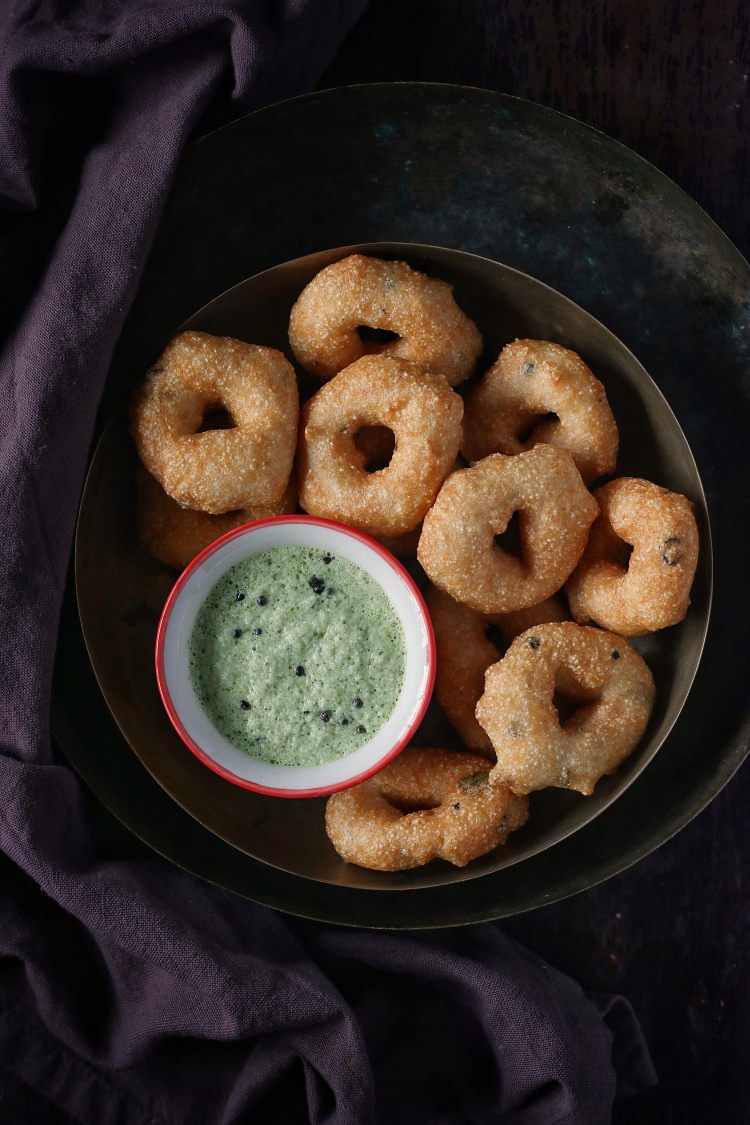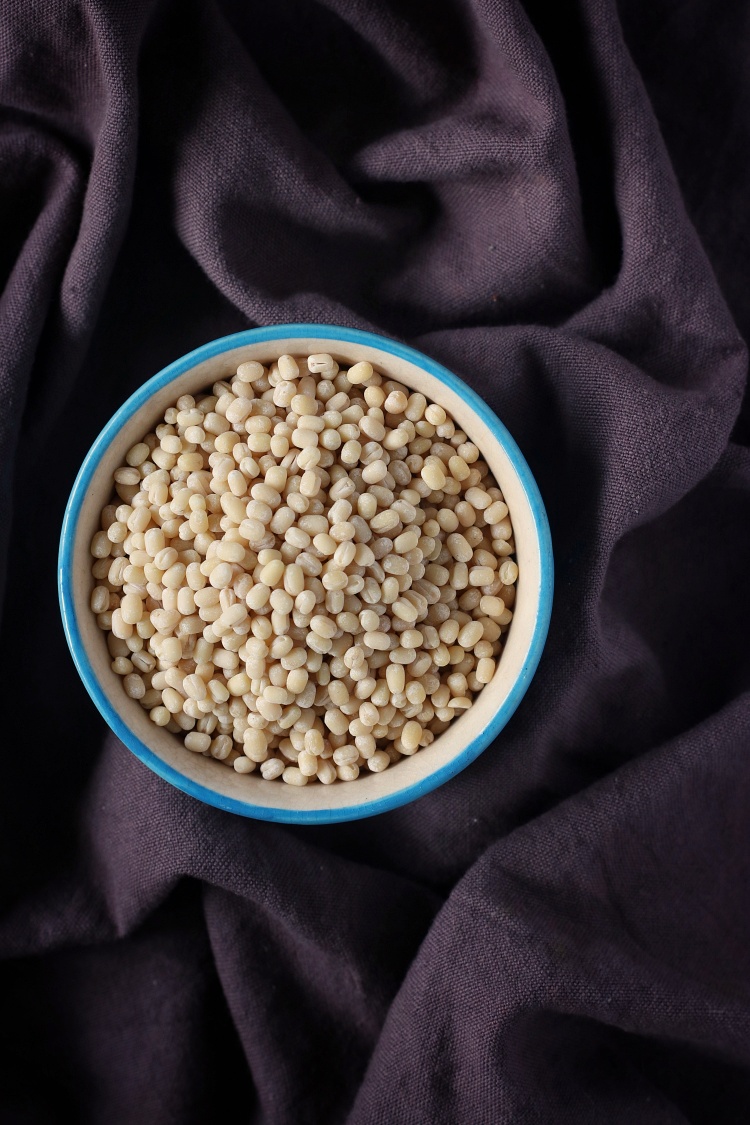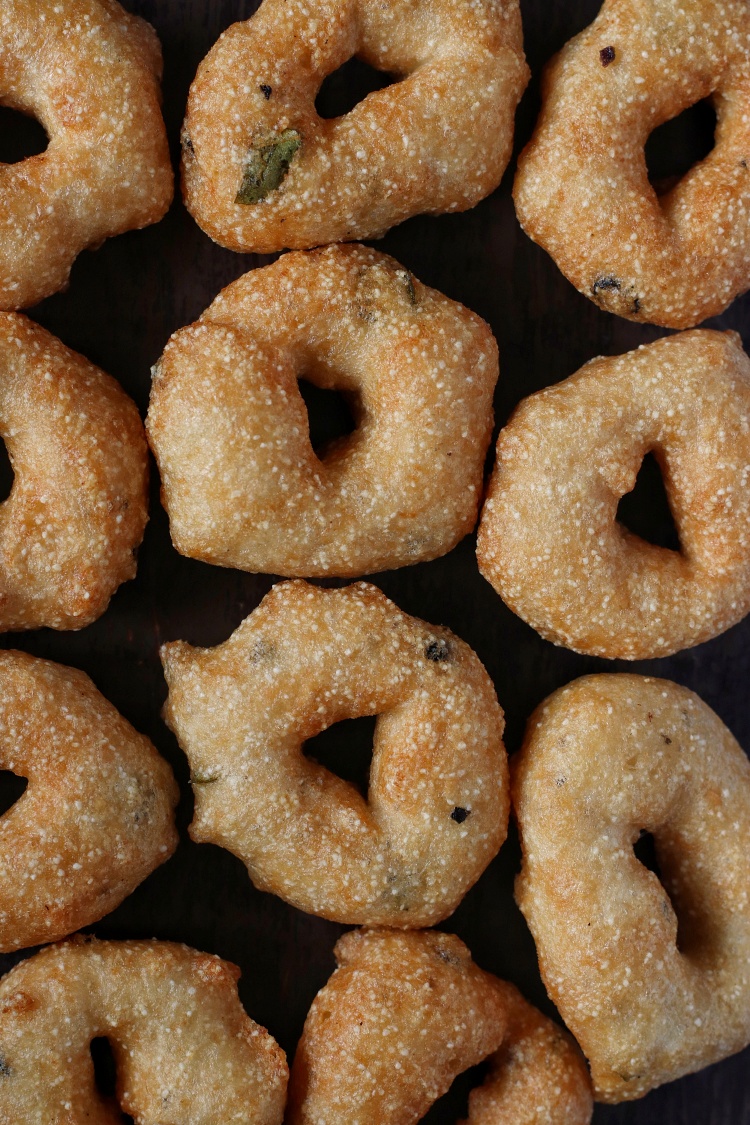The Uzhundhu or Medhu Vadai (or Vada) is an outwardly crisp and internally spongy South Indian lentil fritter. It is also known as Uddina Vada, Garelu, and Uzhunnu Vada depending on where in South India you are. I make it on and off and don’t know why it’s taken me so long to post it. A Vada generally refers to a fritter made usually from lentils or even potatoes.

The Vadai has been around for a very long time. Food historian K. T. Achaya mentions the Vadai (Vada) was popular as far back as 100 BCE – 300 CE among ancient Tamils. The Vada (Vataka) is mentioned in the Manasollasa, a 12th-century Sanskrit encyclopedia compiled by King Someshvara III of Karnataka.
You might find Uzhundhu or Medhu Vadai being referred to as savoury Indian doughnuts. While I understand the attempt to translate something local to English, that’s doing both the Vadai and doughnuts a disservice. Uzhundhu or Medhu Vadai is not fermented, and the texture, though spongy, is very different from a doughnut. The only thing both have in common is that they’re round with a hole and deep fried. This Vadai at its simplest, the way we make them at home, is with a salted lentil batter flavoured with only curry leaves and black pepper. Uzhundhu is the Tamil name for black gram lentils or urad dal. Skinned whole urad dal is preferred for grinding but split lentils will do
These Vadai is typically served in restaurants for breakfast with Idlis, or Dosas with Coconut Chutney and Sambhar on the side. I don’t have any memories of ever eating them for breakfast at home. They were always served at lunch, or eaten as a snack in the evening with coffee. There are versions with green chillies, ginger, onions, etc., but my personal favourite is the traditional plain Jane kind.

The perfect Vadai would be golden brown and crisp on the outside while spongy on the inside. They to tend to lose their crispness after a few hours though especially humid weather. There are a few secrets to making the perfect Uzhundhu Vadai. The lentils must be soaked for about 4 hours till really soft. Undersoaked lentils will make hard Vadai. Then it is important to drain the water completely.
The soaked and drained lentils must be ground to a smooth batter with very little water. If there’s too much water in the batter, it will make the batter difficult to shape. The fritters will also be greasy. If by some chance the batter turns out looser in consistency, mix in a couple of tablespoons of semolina (rava). This will absorb the excess water and also make crispier Vadai.
The Vadai should be fried in medium hot oil. This allows them to cook through slowly. You will have greasy Vadai if the oil isn’t hot enough and under cooked ones if the oil is too hot.
Once the batter is ready, mix it with your hand or a spoon or fork a few times to incorporate air into it. You should have a slightly soft and fluffy batter. This will make your Vadai soft and spongier.

Shaping the Vadai can be a bit tricky if you’re new to making these Vadai. One way out is to use a Vada maker to drop the batter into the oil. Otherwise it needs just a little practice with the traditional method and you’ll be making perfect Vadai. The lentil batter must be of the right consistency, though. You can use just your palm and fingers to shape the Vadai. You might find it easier to shape the Vadai on a damp piece of banana leaf.
Uzhundhu or Medhu Vadai
Ingredients
- 1 cup skinned whole or split black gram lentils urad dal
- 2 tsp coarsely crushed black peppercorn
- 2 sprigs curry leaves torn in small pieces
- Salt to taste
Instructions
- Wash the skinned black gram lentils or urad dal and soak in water for about 4 hours. The lentils will swell up to almost double and be very soft. Drain well and grind to a very fine paste adding very little water.
- If your batter seems a little too loose. Mix in a tablespoon or two of semolina (rava) and let it sit for 10 minutes. Using you hand, or a spoon/ fork beat the batter for a couple of minutes till it is well aerated and fluffy. Mix in salt, curry leaves and crushed peppercorns. You may refrigerate the batter at this point till later. Just remember to beat and aerate once again just before making the Vadai.
- Once you’re ready to make the Vadai, heat oil in a wok. The oil should be reasonably hot. Shape the Vadai according to your preference with a Vada maker, your palm and fingers or on a banana leaf. This is how I do it.
- Dampen your inner inner with water. This prevents the batter from sticking. Pick up a small bit of batter with the fingers of your right hand. Shape it into a rough flattish ball of sorts on your four fingers. Use the tip of your thumb to do this. Then poke a hole in the middle using your thumb. Hold your palm carefully over the oil, inner side facing the oil. The shaped batter will slowly drop off your palm into the hot oil.
- Depending on the size of your wok or pot, you can fry about 4 or 5 at a time, or more. Don’t over crowd them in the oil. Fry the Vadai on medium to high heat, turning them over a few times till crisp, done and golden brown.
- Remove from oil and let them drain on paper towels. Serve hot with Sambhar and Coconut Chutney.

Leave a Reply